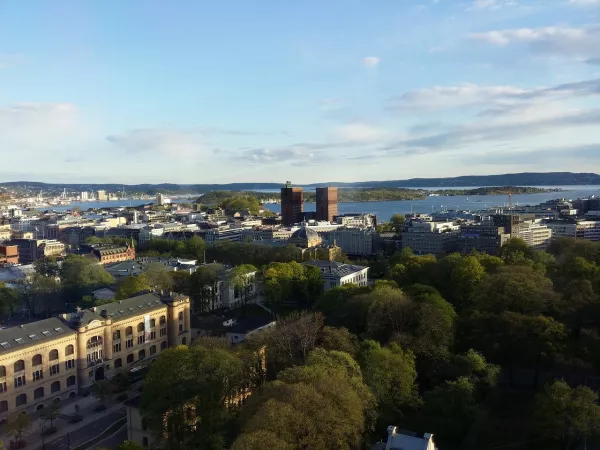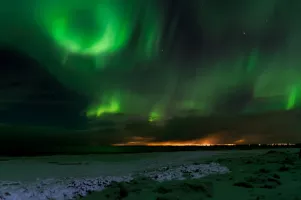
Oslo Travel Guide
Oslo, the capital of Norway, is a vibrant city known for its rich history, stunning natural beauty, and unique cultural experiences. Situated on the Oslofjord, this Scandinavian gem is famous for its Viking heritage, world-class museums, and green spaces. The city seamlessly blends modern architecture with historic landmarks, offering visitors a perfect mix of tradition and innovation. Oslo is also renowned for its commitment to sustainability and outdoor activities, making it a must-visit destination for eco-conscious travelers.Top Attractions in Oslo
- Vigeland Sculpture Park
- The Viking Ship Museum
- The Royal Palace
- Oslo Opera House
- Norsk Folkemuseum
Oslo is Famous for
Scenic fjords and Viking history.Top Attractions in Oslo
- Exploring the fjords
- Visiting the Holmenkollen Ski Jump
- Trying traditional Norwegian cuisine
- Experiencing the Northern Lights
What's Great about Travelling to Oslo?
- Stunning natural landscapes
- Rich cultural heritage
- Safe and eco-friendly city
What's Not So Great about Travelling to Oslo?
- High cost of living
- Cold weather in winter
- Limited daylight hours in winter
Travel Tips for Oslo
- Check visa requirements before travel
- Use public transportation for easy access around the city
- Stay aware of pickpockets in tourist areas
Important Oslo trip information
- Ideal Duration: 3-4 days
- Best Time to Visit: Summer months for outdoor activities
- Nearby Airports and Railway Stations: Oslo Airport and Oslo Central Station
Total
4,09,400
*EXCLUDING APPLICABLE TAXES 5.0 Ratings
( 20 Reviews )
( 20 Reviews )
Total
5,26,500
*EXCLUDING APPLICABLE TAXES 5.0 Ratings
( 20 Reviews )
( 20 Reviews )
Total
2,34,500
*EXCLUDING APPLICABLE TAXES 5.0 Ratings
( 20 Reviews )
( 20 Reviews )
Total
4,07,000
*EXCLUDING APPLICABLE TAXES 5.0 Ratings
( 20 Reviews )
( 20 Reviews )
Per Person
3,89,500
*EXCLUDING APPLICABLE TAXES 5.0 Ratings
( 20 Reviews )
( 20 Reviews )
Total
3,81,000
*EXCLUDING APPLICABLE TAXES 5.0 Ratings
( 20 Reviews )
( 20 Reviews )
FAQ's on Oslo
Q1: What is the best time to visit Oslo?
The best time to visit Oslo is during the summer months, from June to August, when the weather is mild and the city comes alive with outdoor festivals and events. However, if you are interested in winter sports or seeing the Northern Lights, then the winter months from December to February are ideal. Spring and autumn are also lovely times to visit for colorful foliage and fewer crowds.
Q2: Do I need a visa to travel to Oslo?
Most travelers do not need a visa to visit Oslo for stays up to 90 days within a 180-day period if they are from the EU/EEA or certain other countries. However, it's essential to check the specific visa requirements based on your nationality before traveling to Oslo. Make sure your passport is valid for at least six months beyond your planned departure date.
Q3: What are the must-visit attractions in Oslo?
Oslo is home to several iconic attractions, including the Viking Ship Museum, the Fram Museum, the Holmenkollen Ski Jump, and the famous Vigeland Sculpture Park. Don't miss the Oslo Opera House, the Royal Palace, and the Akershus Fortress. Take a stroll along Karl Johans Gate, explore the Aker Brygge waterfront, and visit the stunning Oslo Cathedral. Nature lovers should head to the Oslofjord and the nearby forests for outdoor adventures.
Q4: Is Oslo a safe place to travel?
Oslo is generally a safe city for travelers, with low crime rates. However, as with any destination, it's essential to stay vigilant, especially in crowded tourist areas and public transport. Avoid flashing valuables and be cautious at night. While Oslo is safe, it's always a good idea to have travel insurance that covers theft, loss, and medical emergencies.
Q5: What is the local currency in Oslo and can I use credit cards?
The local currency in Oslo is the Norwegian Krone (NOK). Credit cards are widely accepted in hotels, restaurants, and shops, but it's recommended to carry some cash for smaller purchases and local markets. ATM machines are readily available throughout the city, and major credit cards like Visa and MasterCard are commonly used.
Q6: What is the local cuisine like in Oslo?
Oslo offers a diverse culinary scene, with traditional Norwegian dishes like rakfisk (fermented trout), reindeer meat, and rømmegrøt (sour cream porridge). Seafood lovers will enjoy fresh salmon, cod, and shrimp. Don't miss trying the popular open-faced sandwiches known as smørbrød. For sweet treats, indulge in krumkake (thin waffle cookies) or skillingsboller (cinnamon rolls). Vegetarian and international cuisine options are also widely available in Oslo.
Q7: What transportation options are available in Oslo?
Oslo has an efficient public transportation system, including buses, trams, metro, and ferries that connect the city and its surroundings. The Oslo Pass offers unlimited travel on public transport and free admission to many attractions. Taxis are available but can be expensive, so consider using ride-sharing services. Renting a bike is a popular and eco-friendly way to explore the city. Walking is also a great option, especially in the city center.
Q8: Are there any cultural norms or etiquette I should be aware of when visiting Oslo?
When visiting Oslo, it's essential to respect the local customs and etiquette. Norwegians value punctuality, so be on time for appointments and tours. Tipping is not mandatory but appreciated for good service. Remove your shoes when entering someone's home and address people by their titles and surnames until invited to use their first name. Public displays of affection are generally kept to a minimum in Norway. Remember to be environmentally conscious and follow the "leave no trace" principle when exploring nature.
Q9: I am a travel agent. How can I buy travel leads of Oslo?
Register yourself as a travel agent at agents.tripclap.com and then you can buy travel leads to Oslo once your account is approved. For more details contact our support team at +91-8069186564 or support@tripclap.com



